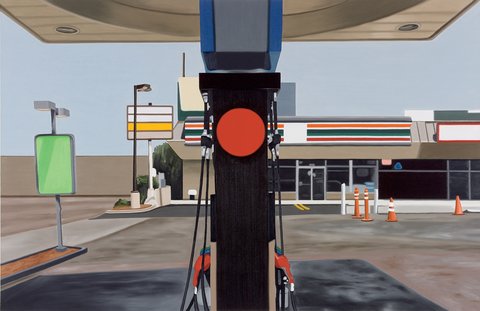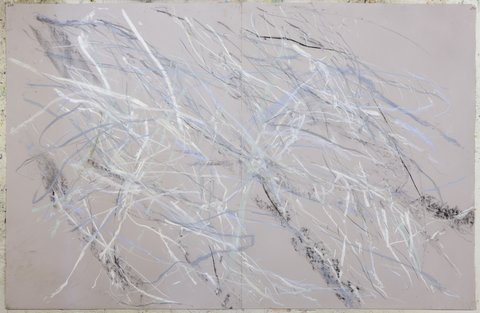As modernism’s options dwindled and artists began to re-explore previously banned alternatives, in the 1980’s, the Pandora’s box filled with illusion, metaphor, narrative, historic styles, a panoply of nudes and more was pried open. Post modernism the accumulation of these new freedoms was labeled, as so many of the referents that had influenced modernism’s abstractions took on more mimetic form – flowerbeds might now arise out of Joan Mitchell’s radiant abstract bursts of color titled Sunflowers; the rhythms of the ocean addressed with such lyric anxiety by Jackson Pollock might be more consciously regimented into recognizable sequences of waves, etc. Modernism would become but one of many possibilities for an artist. Landscape found fertile ground and pastorale could flourish. The ever-changing look of landscape-oriented art with or without participating figures becoming a pastorale gave rise to this exhibition. Not a grand survey but a small selection of works by seven artists who have impacted my mental landscape. Seven artists, each one’s work occupying one of the seven available rooms of the exhibition space.
Curated by Klaus Kertess
Featuring:
Peter Cain
Carroll Dunham
Robert Harms
Susan Hartnett
Dona Nelson
Alexander Ross
Richard van Buren
In the late 1980s, Peter Cain (1959 – 1997) painted cars variously truncated and most often stood on end and painted in searing fetish finish to become mysterious icons of mechanization. In the last year of his life, he turned to the landscape configuration best known to him– the gas station. His gas stations, with their emphasis on primary colors, severely geometricized composition almost totally limited to vertical and horizontal elements, and absence of all human and automobile presence might have been designed by a tem of Mondrian and DeChirico.

When Carroll Dunham (1949 - ) came to New
York, in 1972 he grew familiar with the work of Mel Bochner and Barry Le Va, and was particularly drawn to the paintings of Brice Marden and Robert Mangold. At the same time he was also drawn to still discredited Surrealism, especially the slippery high-resolution landscape phantasms of Yves Tanguy and Roberto Matta
and the psychedelia of the 1960s. In the mid 1980s, he suddenly began to paint on wood grain, now heightening its patterning, now exploding its organics in Technicolor delirium, to release him into the wilder shores of his imagination.
night%20and%20day%206.jpg)
Robert Harms (b. 1962 -) has lived and painted by the water on Long Island’s East end for most of his career. He now lives in a small house directly overlooking (almost in) a pond. He paints the pond, its myriad of reflections on its rippling surface, from season to season to season with
a myriad of strokes delicately reveling in their liquidity. Varied in their size and shape and color they gather in an open aqueous rectangle surrounded by bare white canvas – something like a vertical pond – limpid, lyric, clear.
Susan Hartnett (b. 1940 -) moves back and forth between lower Manhattan and rural Maine. Wherever she is located she absorbs nature. In New York, she can sit in a park and watch the dance of grasses for I don’t know
how long, and then return to her loft and choreograph graphite to dance on paper like the grass – with concentrated directness. Or she can sit in Central Park and visually and emotionally gather up the plants and atmospherics and bring this fragile freight back home and lay it out on a large sheet of colored paper in a vibrant flurry of pastels (she is also most articulate in her verbal descriptions). For years she has been doing this – invoking the weather and the plant life she has communed with.

An autographic style has never interested Dona Nelson (b. 1947 -). She has moved freely from the figurative to the abstract, from delicate stain to coruscating physicality bolstered by paint-soaked patches of muslin and/or cheesecloth. She might riff on paintings her mother once made or The Stations of the Subway. At times it seems as though she has as many hands conspiring at once to create a painting as the octopuses she has so wonderfully painted have tentacles. Whether
double-sided or single the dynamics of her paint at once challenge and respect the rectangularity of the canvas.
Alex Ross (1960 - ) has more literally than Dunham revived Surrealism’s science-fictional landscapes. Employing a highly idiosyncratic process, he sculpts small forms out of green Plasticene that then become models for his painting. While his ambivalently horticultural forms often call to the Surrealism of such as Tanguy, he does not engage in the precisely delineated pictorialism Tanguy employed. Ross’
paintings are prone to a lush creamy physicality, visceral and visually sexy.
Richard Van Buren (b. 1937 -) now lives and works in Maine not far from Hartnett. He was in the 1966 landmark exhibition Primary Structures in the Jewish Museum in New York. This was the earliest gathering of what was known as Minimalism. Van Buren worked with cut and planed timber architected into clear geometric configurations and coated with fiberglass. In more
recent years he dispensed with the wood structure and encouraged the fiberglass’ flow into organic, distended pours emblazoned with countless colored pins. The organics of his making seemed to call to the underwater
realms of coral.